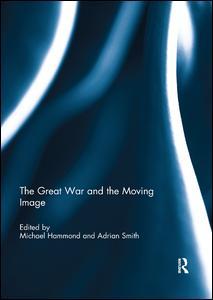The Great War and the Moving Image
Coordonnateurs : Hammond Michael, Smith Adrian

The Great War and the Moving Image focuses upon the Allied war effort on the Western Front and in the Mediterranean. In doing so, the book addresses topics ranging from how carefully selected images projected a positive portrayal of ambulance trains, through film?s instructional role promoting self-sufficiency on the home front, to the vital role of makeshift YMCA cinemas both sides of the Channel.
With editors and contributors who are authorities on cinema in wartime Britain and on the British response to the challenge of ?total war?, the volume highlights the power that the moving image had during the Great War. In the introduction, the editors consider why the First World War can be seen as the first uniquely cinematic conflict. Later, historians from Britain, Australia, and America go on to explore film?s pioneering role as a powerful vehicle for propaganda at home and abroad, and its contribution to maintaining morale among soldiers on the front line as well as across civilian audiences back home. The book concludes by considering the representation of trench warfare in today?s hi-tech computer games.
This book was originally published as a special issue of the Historical Journal of Film, Radio and Television.
Introduction: The Great War and the Moving Image 1. Writing History on the Page and Screen: Mediating Conflict through Britain’s First World War Ambulance Trains2. Everybody’s Business: Film, Food and Victory in the First World War3. Forgetting their troubles for a while: Australian soldiers’ experiences of cinema during the First World War4. Putting the moral into morale: YMCA cinemas on the Western Front, 1914-19185. ‘Snapshots’: Local Cinema Cultures in the Great War6. Pixel Lions – the image of the soldier in First World War computer games
Michael Hammond is an Associate Professor in Film History at the University of Southampton, UK. He has written extensively about cinema and the First World War, including The Big Show: British Cinema Culture and The Great War (2006). His current research is concerned with the impact of the First World War on the aesthetic practices of the Hollywood studios between 1919 and 1939.
Adrian Smith is Emeritus Professor of Modern History at the University of Southampton, UK, and is currently writing the authorised biography of the industrialist and aviation pioneer Sir Richard Fairey. He has previously written biographies of Lord Mountbatten and the First World War ace Mick Mannock, and a history of the New Statesman.
Date de parution : 02-2019
17.4x24.6 cm
Disponible chez l'éditeur (délai d'approvisionnement : 14 jours).
Prix indicatif 46,39 €
Ajouter au panierDate de parution : 08-2017
17.4x24.6 cm
Disponible chez l'éditeur (délai d'approvisionnement : 14 jours).
Prix indicatif 160,25 €
Ajouter au panierThème de The Great War and the Moving Image :
Mots-clés :
Young Men; First World War; British Camps; First World War propaganda; RSSILA; Historical Journal of Film; Radio and Television; Contemporary British Media; film audiences; YMCA Hut; film propaganda; Train Errant; home front; YMCA Archive; war computer games; War Time; wartime cinema; County War Agricultural Committees; wartime morale; National War Aims Committee; Adrian Smith; Regular Cinema Goer; Rebecca Harrison; Valiant Hearts; Stella Hockenhull; Stevens Point; Amanda Laugesen; YMCA Worker; Emma Hanna; Grand Opera House; Leen Engelen; Fps Game; Leslie Midkiff DeBauche; World War Games; Chris Kempshall; Australian Soldiers; World War Soldiers; Firemen; Chaplin Films; Transnational Popular Culture



